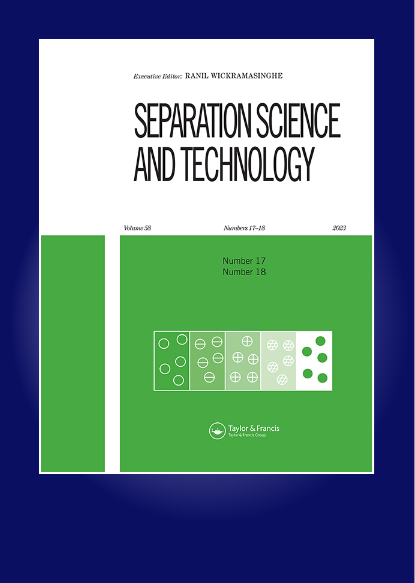Synthesis and characterization of pectin-xanthate and their application in heavy metal and lignin enriched paper industry wastewater treatment
IF 2.3
4区 工程技术
Q3 CHEMISTRY, MULTIDISCIPLINARY
引用次数: 0
Abstract
ABSTRACTThree grades of pectin xanthates (PX1, PX2, and PX3) have been prepared by the reaction of pectin with carbon disulfide (CS2) in an alkaline medium using NaOH, via the xanthation process. The percentage yield of prepared pectin xanthates has been found to be 87.06%, 90.38%, and 93.80% for PX1, PX2, and PX3, respectively. Prepared pectin xanthates and raw pectin were utilized for heavy metals (Cu(II) and Ni(II)) and lignin enriched paper industry wastewater (LEPIW) treatment. The removal percentage of pectin, PX1, P X2, and PX3 for Cu removal at optimum condition (adsorbent dose: 5.14 g/L, pH: 5 for Cu and 7 for Ni, optimum temperature: 50°C and time: 80 min for Cu(II) and 100 min for Ni(II)) has been found as 85%, 92.33%, 93.5%, and 94.66% and 76.66%, 89.44%, 91.66%, and 93.33%, respectively, for Ni removal. The LEPIW treatment efficacy for pectin, PX1, PX2, and PX3 has been found to be 54%, 77%, 83%, and 86% for the initial COD: 2000 mg/L, pH: 7, optimum temperature: 40°C in 105 min operation time. Adsorption isotherm studies suggest that Langmuir isotherm is most appropriate which indicates adsorption follows chemisorption. The adsorption capacities of PX1, PX2, and PX3 are found as 309.59, 352.11, and 380.22 mg/g for Cu(II) and 299.40, 315.45, and 328.94 mg/g and for Ni(II), respectively, which is very high in comparison with many other recent literature studies.KEYWORDS: Xanthateadsorptionpaper wastewaterheavy metalCOD removal Disclosure statementNo potential conflict of interest was reported by the author(s).Manuscript’s most relevant contributions Synthesis and characterization of three grade pectin xanthate for wastewater treatment.Cu removal in the range of 85–95% for an initial load of 2000 mg/L.Ni removal in the range of 76–93% for an initial load of 2000 mg/L.Adsorption capacities are found between 309 and 380 mg/g for Cu removal.Adsorption capacities are found between 299 and 329 mg/g for Ni removal.LEPIW treatment efficiency in the range of 54–76% for an initial COD of 2000 mg/L.果胶黄药的合成、表征及其在重金属和木质素富集造纸废水处理中的应用
摘要以果胶和二硫化碳(CS2)为原料,在碱性介质中以NaOH为溶剂,通过黄原化法制备了3个等级的果胶黄原酸盐PX1、PX2和PX3。PX1、PX2和PX3的果胶黄药得率分别为87.06%、90.38%和93.80%。利用制备的果胶黄药和生果胶处理重金属(Cu(II)和Ni(II))和木质素富集造纸废水(LEPIW)。在最佳条件下(吸附剂用量为5.14 g/L, Cu为pH 5, Ni为pH 7,最佳温度为50℃,Cu(II)为80 min, Ni(II)为100 min),果胶、PX1、px2和PX3对Cu的去除率分别为85%、92.33%、93.5%和94.66%;对Ni的去除率分别为76.66%、89.44%、91.66%和93.33%。在初始COD为2000 mg/L、pH为7、最佳温度为40℃、操作时间为105 min的条件下,LEPIW对果胶、PX1、PX2和PX3的处理效果分别为54%、77%、83%和86%。吸附等温线的研究表明,Langmuir等温线是最合适的,这表明吸附先发生在化学吸附之后。PX1、PX2和PX3对Cu(II)的吸附量分别为309.59、352.11和380.22 mg/g,对Ni(II)的吸附量分别为299.40、315.45和328.94 mg/g,与最近的许多文献研究相比,这是非常高的。关键词:黄原酸吸附造纸废水重金属cod去除披露声明作者未报告潜在利益冲突。废水处理用三级果胶黄药的合成与表征。当初始负荷为2000 mg/L时,Cu去除率为85 ~ 95%。当初始负荷为2000 mg/L时,Ni去除率为76 ~ 93%。对铜的吸附量在309 ~ 380 mg/g之间。对镍的吸附量在299 ~ 329 mg/g之间。当初始COD为2000 mg/L时,LEPIW的处理效率在54 ~ 76%之间。
本文章由计算机程序翻译,如有差异,请以英文原文为准。
求助全文
约1分钟内获得全文
求助全文
来源期刊

Separation Science and Technology
工程技术-工程:化工
CiteScore
6.10
自引率
3.60%
发文量
131
审稿时长
5.7 months
期刊介绍:
This international journal deals with fundamental and applied aspects of separation processes related to a number of fields. A wide range of topics are covered in the journal including adsorption, membranes, extraction, distillation, absorption, centrifugation, crystallization, precipitation, reactive separations, hybrid processes, continuous separations, carbon capture, flocculation and magnetic separations. The journal focuses on state of the art preparative separations and theoretical contributions to the field of separation science. Applications include environmental, energy, water, and biotechnology. The journal does not publish analytical separation papers unless they contain new fundamental contributions to the field of separation science.
 求助内容:
求助内容: 应助结果提醒方式:
应助结果提醒方式:


